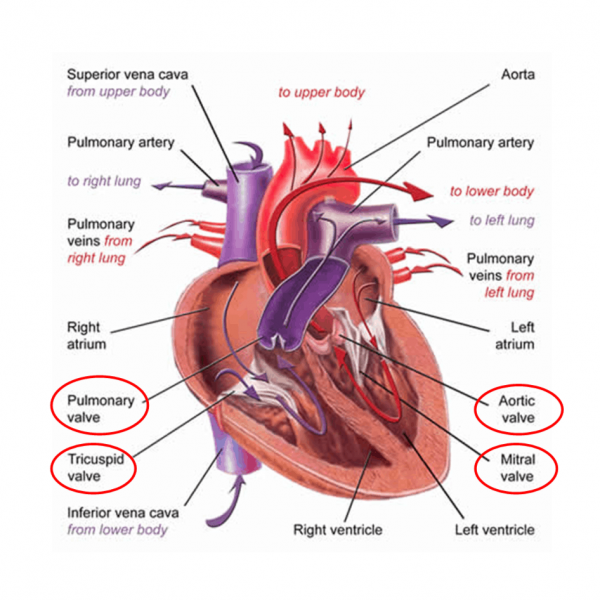Valve Disease
The four chambers of the heart are separated by one-way valves to ensure efficient forward flow of blood from chamber to chamber and into the main blood vessels, the aorta and pulmonary artery. There are four main valves (see figure), two on the left side, the aortic valve and mitral valve, and two on the right side, the pulmonary valve and tricuspid valve.

There are two main types of valve disease: narrowing, which makes it harder for the heart to propel blood through the valve; and leakage, such that the blood expelled leaks back across the valve making the heart pump inefficiently. Some patients will have a mixture of the two. Valve disease can be congenital, meaning that a patient is born with an abnormal valve, or acquired, developing in later life. In the past the most common cause of valve disease was rheumatic fever, but this is now rarely seen in the Western world. As life expectancy has gradually increased the most common cause of valve disease is degenerative, due to wear and tear over the years; this is not surprising considering that the heart beats 90,000 to 100,000 times or more every day and all four valves open and close with every beat. Valves are extremely fine structures, less than 4 mm thick, and are subjected to tremendous pressure gradients across them.
In the early stages of valve disease there are no symptoms, although the noise generated by a narrowed or leaking heart valve may be detectable as a heart murmur using a stethoscope. As the valve disease progresses, the heart begins to feel the strain and symptoms such as breathlessness, reduced exercise capacity, fatigue, palpitations and fluid retention begin to develop. It is important that valve problems are picked up early, before the heart muscle becomes strained, since effective and timely treatment with medicines, and valve replacement or repair if necessary, minimise the risk of permanent damage to the heart.

Related links:
Symptoms - Breathlessness and fluid
retention
Breathlessness, or dyspnoea, is a common symptom of several medical disorders. Read more
Tests - Echocardiography
Echocardiography is the study of the heart using ultrasound. Similar to a scan of a baby undertaken during pregnancy, an ultrasound probe applied to the chest wall can be used to study the heart. Read more
Treatments - Valve Repair/Replacement
Heart valve surgery has a history dating back more than 60 years and during this time surgical techniques and types of artificial heart valve (known as valve prostheses) have been refined. Read more
Treatments - TAVI
With the ageing of the general population in Western society we are seeing an ever increasing number of older patients, typically in their 70s, 80s or older, with wear and tear of the main heart valve, the aortic valve. Read more
Treatments - MitraClip
The mitral valve is a highly complex structure, comprising two leaflets, which acts like a one-way valve between two chambers, the left atrium and left ventricle. Read more